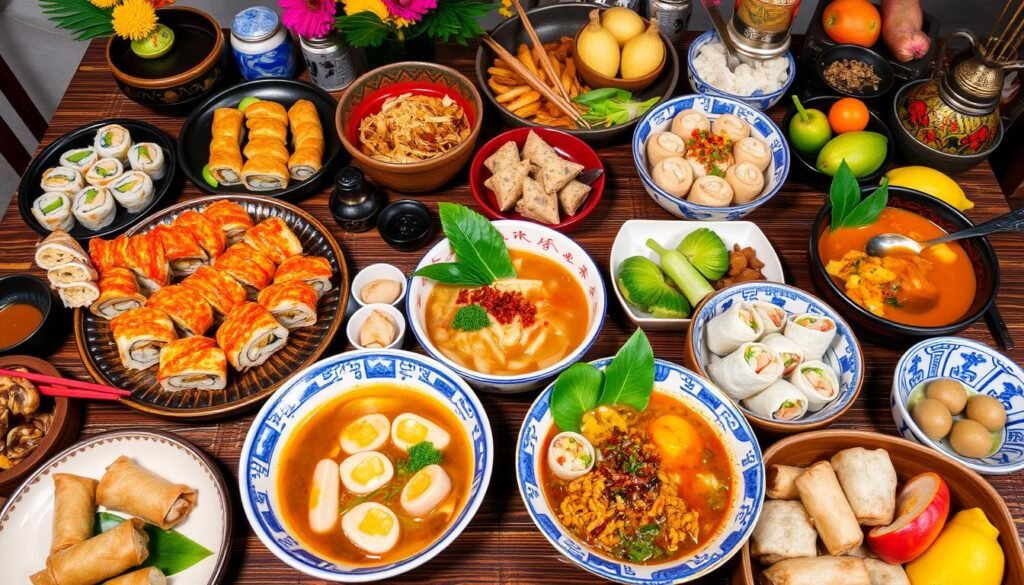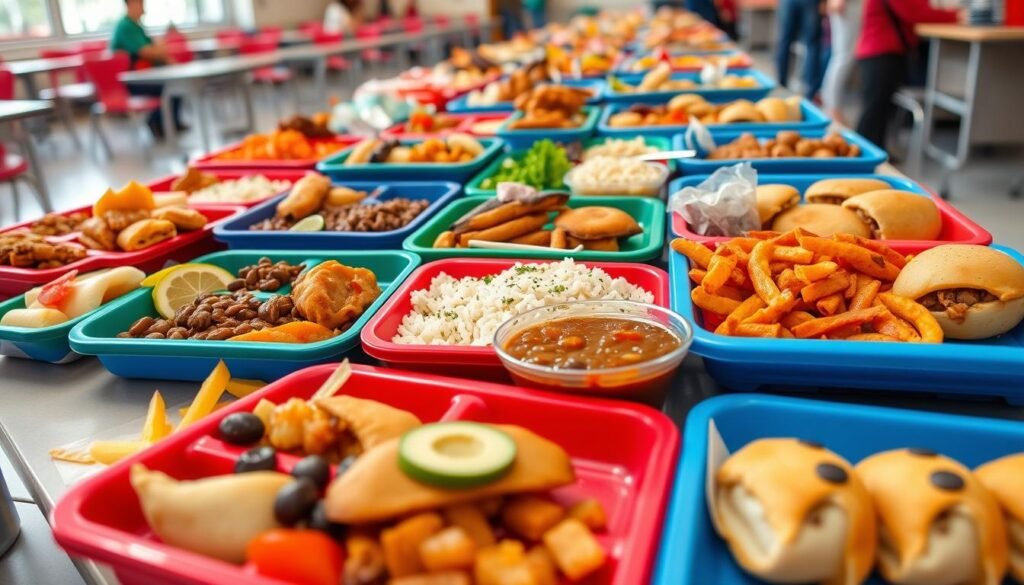School Lunches Around the World: A Global Cafeteria Tour

School lunches offer a glimpse into global culinary traditions and nutritional standards. From Japanese bento boxes to French gourmet meals, each country puts its unique spin on cafeteria food. Let’s explore the vibrant world of international school meals and their cultural significance.
These lunches showcase diverse customs and menu staples across the globe. They play a vital role in promoting health, education, and cultural awareness in communities. Understanding this global landscape can inspire new ideas for improving school meal programs.
Key Takeaways
- School lunches reflect the diverse culinary traditions and nutritional standards of countries worldwide.
- Unique lunch customs, menu staples, and tray-to-tray variations exist across the globe, from Japanese bento boxes to French gourmet meals.
- School meals play a vital role in promoting health, education, and cultural awareness in different communities.
- Initiatives like sourcing local ingredients and incorporating traditional dishes are shaping the future of school lunches globally.
- Understanding the global landscape of school lunches can inspire new ideas and best practices for improving school meal programs.
The Importance of School Lunches Worldwide
School lunches are crucial for children’s health and education globally. Good nutrition during school impacts a child’s physical, cognitive, and social growth. Nutritional standards for school meals differ widely among countries.
Some nations focus on organic ingredients. Others prioritize balanced, cost-effective options. These choices shape students’ eating habits and overall well-being.
Nutritional Standards Across Countries
The U.S. National School Lunch Program serves over 30 million students daily. It provides meals that meet specific nutritional requirements.
Japan and South Korea use lunchtime to teach about nutrition and culinary skills. Brazil and Italy emphasize local, organic ingredients in their school meal programs.
The Role of School Meals in Education
School lunches do more than just nourish growing bodies. They play a crucial role in a child’s overall educational experience.
Studies show well-fed students perform better academically. They also exhibit improved behavior and social skills. School meal programs can address food insecurity issues.
These programs promote dietary diversity in education. They ensure all students have access to the nutrition across nations needed to thrive.
| Country | School Meal Highlights |
|---|---|
| United States | The National School Lunch Program serves over 30 million students daily, with meals meeting specific nutritional requirements. |
| Japan | School lunches are used as an opportunity to teach students about the importance of nutrition, service, and culinary skills. |
| Brazil | The school feeding program provides meals to over 43 million children, with a policy requiring a minimum of 30% organic and locally sourced ingredients. |
The importance of nutritious school meals worldwide can’t be overstated. World school menus are evolving to meet students’ needs.
Prioritizing children’s health through school lunches is an investment in our future. It creates a more equitable and prosperous world for all.
“Every $1 invested in school meals has shown a $9 return on investment.”
Unique Lunches in Asia
Asian school lunches offer a delightful mix of flavors and traditions. From Japan’s bento boxes to India’s spicy meals, these lunches showcase diverse culinary experiences. Students worldwide enjoy these multicultural cafeteria offerings.
Japan: The Bento Box Experience
Japanese students enjoy carefully packed bento boxes for lunch. These containers include milk, miso soup, white rice, and pork with fresh vegetables. Some schools have gardens, providing homegrown ingredients for healthy lunches.
South Korea: A Flavorful Spread
South Korean school lunches highlight the country’s rich food culture. Meals typically include rice, soup, kimchi, and mixed vegetable side dishes called banchan. Students and teachers often eat together, reflecting the communal aspect of these meals.
India: A Spice-Laden Meal
India has the world’s largest school lunch program, serving over 100 million free meals daily. These meals feature regional specialties like fragrant vegetables, creamy dal, paneer, and nutritious flatbreads. The program aims to nourish children and promote education access nationwide.

“School lunches in Asia offer a vibrant and diverse culinary experience, celebrating the unique flavors and traditions of each country.”
Delicious Dishes in Europe
European school lunches reflect the region’s rich culinary traditions. In Italy, meals use organic ingredients like pasta, meat, vegetables, and fruit. Students enjoy nutritious and flavorful meals made with fresh, high-quality ingredients.
French school lunches are known for their gourmet quality. They offer multi-course meals with salad, meat, vegetables, bread, cheese, and dessert. Some French schools went meatless during the pandemic to simplify lunch service.
Norway: Embracing Simplicity
In Nordic countries like Finland, students enjoy hot lunches of vegetables or soup, meat, fish, and bread. Finland was the first country to offer free lunch to all students. This ensures every child has access to a nutritious meal during school.
| Country | Typical School Lunch | Cost/Affordability |
|---|---|---|
| Italy | Pasta, meat, vegetables, fruit | Affordable, with focus on organic ingredients |
| France | Multi-course meals with salad, meat, vegetables, bread, cheese, dessert | Gourmet quality, with some schools going meatless during the pandemic |
| Finland | Hot meals including vegetables or soup, meat, fish, bread | Free for all students, promoting healthy eating habits |
European schools offer diverse cultural cuisine. This shows their commitment to dietary diversity in education. Students experience world school menus that celebrate their culinary heritage.
Tasty Options in the Americas
School lunches in the Americas offer diverse flavors and culinary traditions. From Mexico’s fajitas and fresh salsa to Brazil’s colorful plates, the region celebrates international school meal options. These global lunch programs showcase multinational lunch offerings across the continent.
Mexico: Fajitas and Fresh Salsa
Mexican school lunches often feature classic dishes like fajitas, tacos, and fresh salsas. These flavor-packed meals provide students with a taste of their culinary heritage. They ensure students start the day energized and well-nourished.
Brazil: A Colorful Plate
Brazilian school meals typically include rice, beans, meat, fruit, and vegetables. Ingredients are often sourced from local, family-run farms. This colorful plate approach ensures nutritional value and introduces students to diverse flavors.
The United States: Classics and Innovations
U.S. lunch options range from salads and sandwiches to pasta and pizza. Many schools offer over 20 choices weekly. However, balancing nutrition and budget constraints remains challenging.
Some schools serve processed foods lacking fresh fruits and vegetables. Yet, innovative initiatives are emerging. These include using local, sustainable ingredients and incorporating global flavors.

“The National School Lunch Program serves almost five billion school lunches annually in the Americas, with more than 30 million students eating school lunches every day.”
Healthy Initiatives Globally
Countries are implementing innovative initiatives to promote healthier school lunch programs. These efforts aim to enhance nutrition, foster dietary diversity, and celebrate cultural cuisine in schools.
Sustainable Ingredients in School Lunches
Sweden provides free hot lunches to all students, focusing on nutritious and sustainable options. The meals feature fresh, locally-sourced ingredients and traditional cooking methods.
Italy and Greece emphasize seasonal, minimally processed foods in their school cafeterias. This approach showcases the region’s culinary heritage.
Government Programs Promoting Health
- In the United Kingdom, campaigns for healthier school meals have led to significant improvements in the quality of food served.
- The Healthy Hunger-Free Kids Act in the United States aims to enhance the nutritional value of school meals by increasing the availability of fruits, vegetables, and whole grains.
- India’s mid-day meal program, serving lunch to over 125 million children aged 6-14, has been running since 1995 at a cost of $2.8 billion to the government.
- Brazil provides school meals for 40 million children, having expanded its program in 2009.
The School Meals Coalition works with over 100 countries and the World Food Programme. Their goal is to provide a healthy meal for every child in school by 2030.
“School meals empower girls by discouraging early marriages, leading to improved educational outcomes.”
These initiatives show global commitment to improve school lunch nutrition. They foster healthier and more diverse dietary habits among students.
Tips for Improving School Lunches
Global culinary traditions offer valuable lessons for enhancing U.S. school lunch programs. Local communities can work towards healthier options and better nutrition education. Introducing global flavors can expand students’ tastes and promote cultural awareness.
Advocating for Change Locally
School lunch improvements often start with grassroots efforts. Parents, teachers, and community members can team up with local schools. They can push for policies that focus on fresh ingredients and reduce processed foods.
The Berkeley Unified School District’s program can inspire similar changes nationwide. Their commitment to better meals shows what’s possible in school nutrition.
Incorporating Global Flavors
Global flavors in school menus can broaden students’ food experiences. They can also foster appreciation for different cultures. Japanese bento boxes or Brazilian plates can make school lunches more exciting.
International influences can create vibrant dining experiences for students. This approach makes meals more inclusive and engaging for all.
Engaging Students in Meal Planning
Involving students in meal planning can boost their interest in school lunches. Japan’s shokuiku approach teaches kids about food prep and nutrition. This method helps build lifelong healthy eating habits.
Giving students a say in menu choices can deepen their nutrition knowledge. It also encourages more thoughtful eating habits among young people.
FAQ
How do school lunches vary across different countries?
School lunches differ greatly between countries, showcasing diverse culinary traditions. From Japanese bento boxes to French three-course meals, each nation offers unique options. These lunches reflect local cuisine and culture, providing students with varied dining experiences.
What is the importance of school lunches globally?
School lunches are vital for children’s health and education worldwide. Nutritional standards vary, with some nations focusing on organic ingredients or balanced meals. Many countries use lunchtime to teach values and nutrition education.
What are some examples of unique school lunches in Asia?
Asian school lunches offer a variety of flavorful options. Japanese students enjoy milk, miso soup, rice, and pork with vegetables in bento boxes. South Korean lunches include rice, soup, kimchi, and mixed vegetable sides called banchan.
India has the world’s largest school lunch program. It serves over 100 million free meals daily. These meals feature vegetables, dal, paneer, and various flatbreads.
How do European school lunches differ from other regions?
European school lunches often reflect the region’s culinary traditions. Italian schools serve organic meals with pasta, meat, vegetables, and fruit. French lunches are known for their gourmet quality, offering multi-course meals.
Nordic countries like Finland provide hot lunches. These typically include vegetables or soup, meat, fish, and bread.
What are some examples of school lunches in the Americas?
School lunches in the Americas offer a wide variety of flavors. Brazilian meals typically include rice, beans, meat, fruit, and vegetables from local farms. U.S. schools provide diverse options like salads, sandwiches, pasta, and pizza.
What healthy initiatives are being implemented in school lunch programs globally?
Many countries are promoting healthy school lunch programs. Sweden offers free hot lunches to all students, focusing on nutritious options. The UK has improved meal quality following campaigns for healthier choices.
Countries like Italy and Greece emphasize fresh, local ingredients. They also promote traditional cooking methods in their school lunch programs.
How can we improve school lunches worldwide?
Improving school lunches involves strategies inspired by global practices. Local advocacy can lead to healthier options and better nutrition education. Introducing global flavors can promote cultural awareness and diverse cuisines.
Engaging students in meal planning, like in some Japanese schools, can boost interest in healthy eating. This approach also enhances food education for students.


![Illinois Asbestos Hotspots: Mesothelioma Risk by County [Interactive Map] illinois asbestos hotspots interactive map](https://grobuzz.co.uk/wp-content/uploads/2025/06/illinois-asbestos-hotspots-interactive-map-390x220.png)


